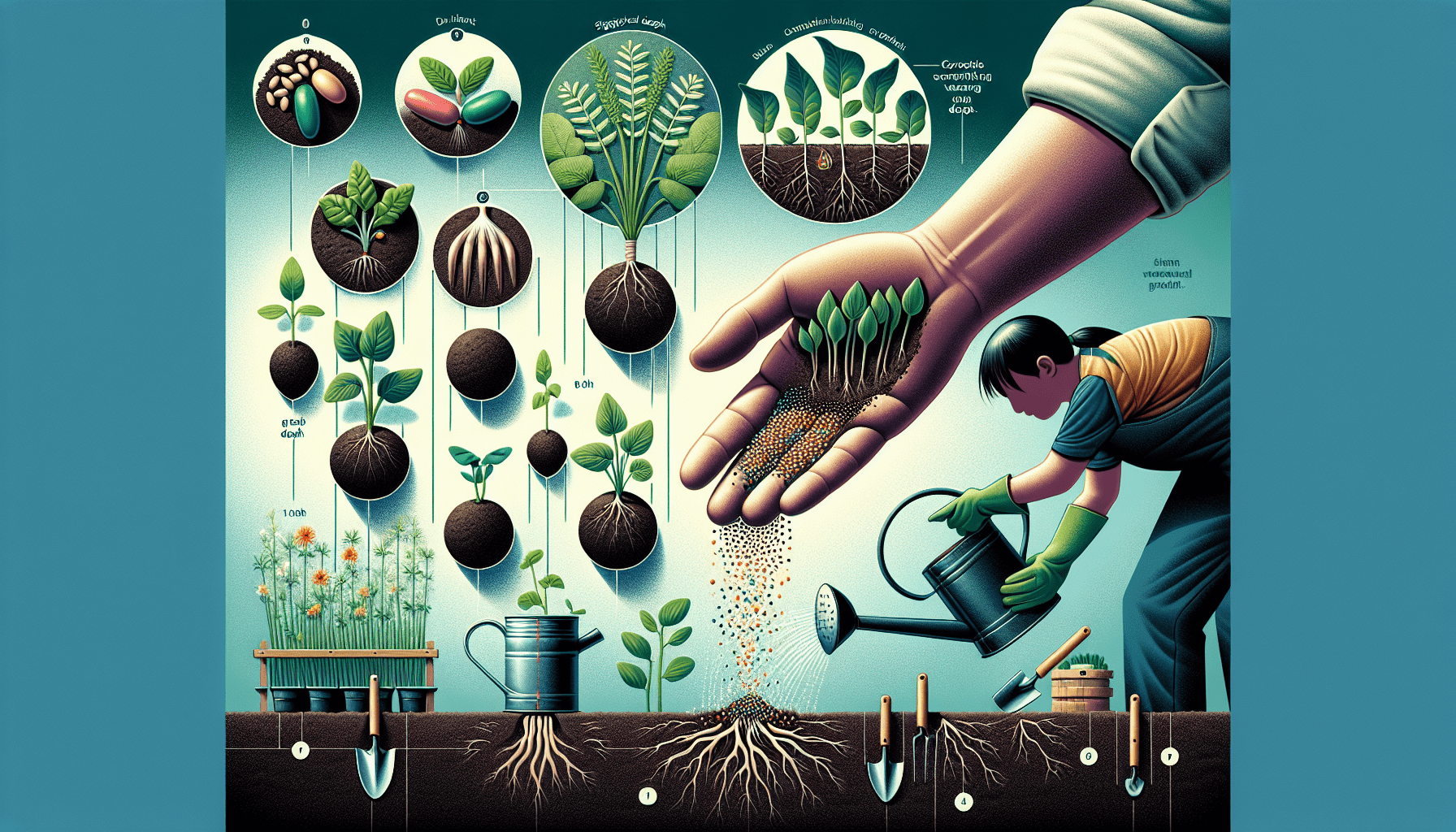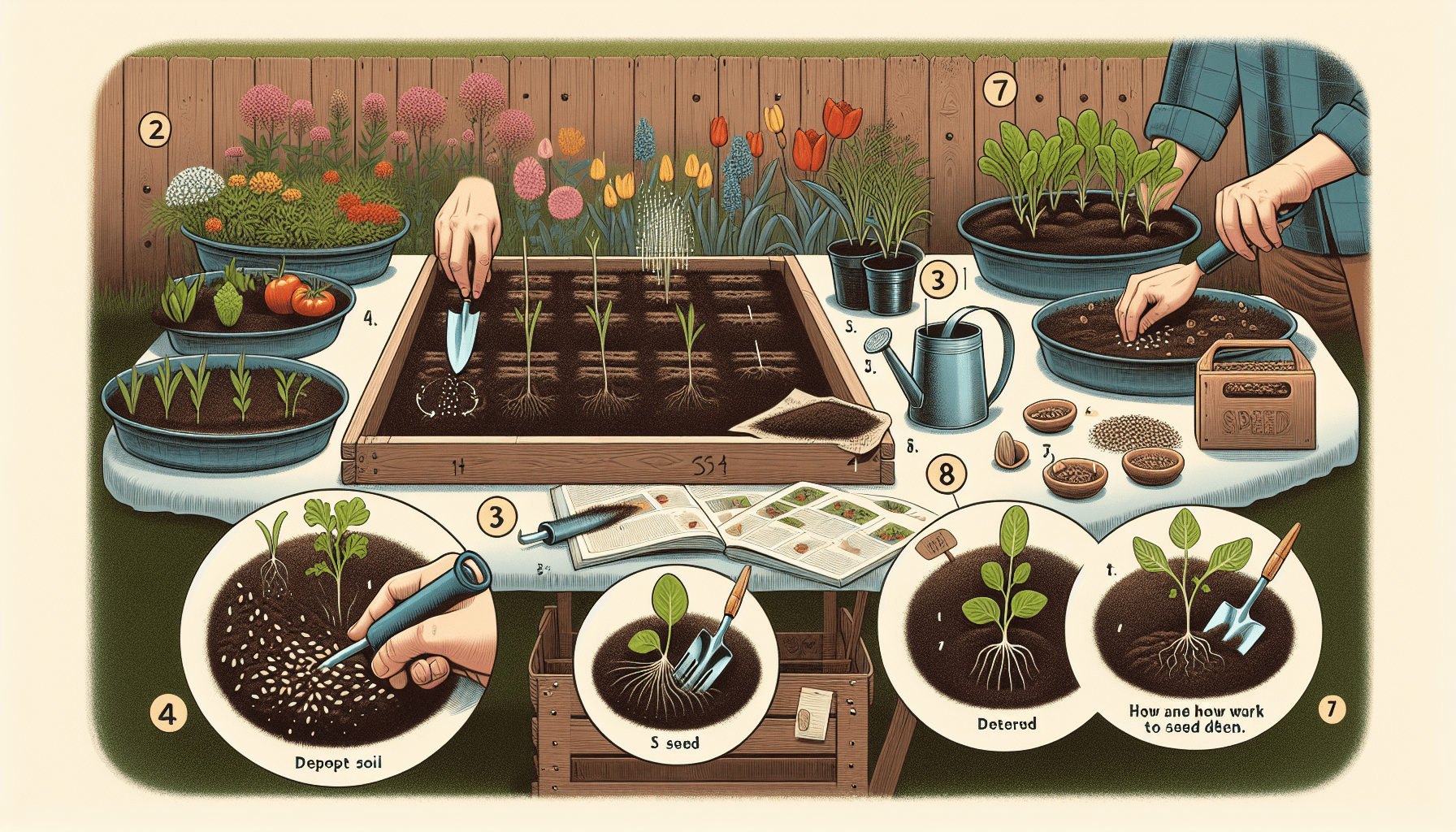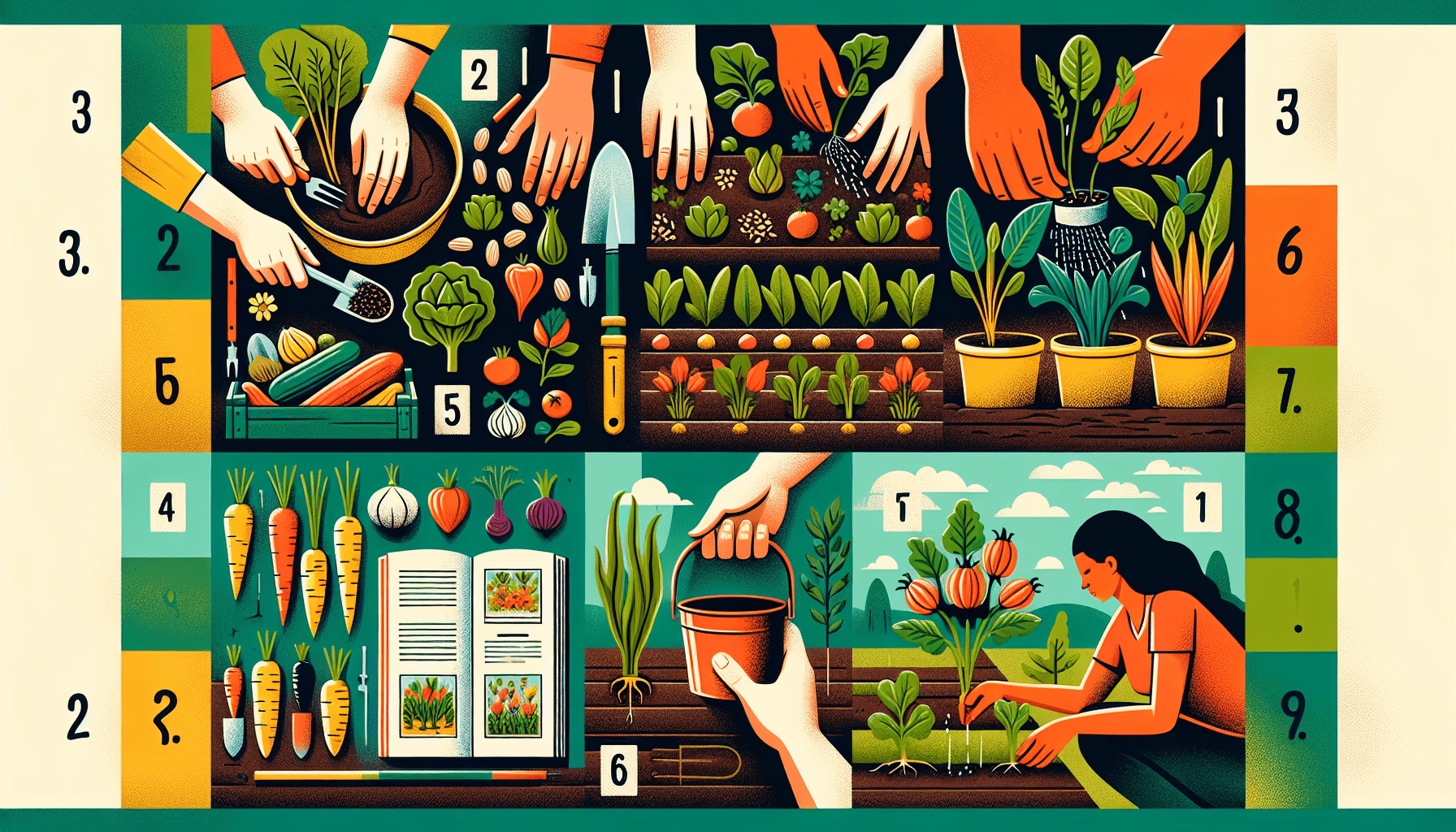
In “6 Simple Steps for Planting Vegetables,” you’ll discover easy-to-follow guidelines to help you successfully grow your own vegetables in your garden. From choosing the right location to nurturing your plants, each step is explained in a brief and friendly manner. Learn how to select an ideal spot for your vegetables, prepare the soil for optimal growth, plan your garden layout effectively, sow seeds or plant seedlings with care, water your plants correctly, and mulch and maintain your garden to keep it healthy and free from pests. By following these six steps, you’ll be well on your way to cultivating thriving and bountiful vegetables in your own backyard.

Choose the Right Location
Importance of sunlight
When choosing a location for your vegetable garden, it is crucial to consider the amount of sunlight the area receives. Most vegetables thrive in a spot that gets at least 6 to 8 hours of sunlight per day. Sunlight is essential for photosynthesis, which is the process by which plants convert sunlight into energy. Without enough sunlight, your vegetables may not grow as well or produce abundant harvests. So, look for a spot in your garden that gets plenty of sunlight throughout the day.
Protection from strong winds
In addition to sunlight, it’s also important to protect your vegetable garden from strong winds. Strong winds can damage young plants, uproot seedlings, and dry out the soil quickly. To shield your plants from strong winds, consider planting them in an area that is sheltered by structures like fences, hedges, or buildings. You can also create windbreaks using porous materials such as lattice screens or row covers. By providing protection from strong winds, you can ensure that your vegetables have a stable and conducive environment for growth.
Benefits of good light
Choosing a location with good light is not only crucial for the growth of your vegetables but also for preventing diseases. When your plants receive sufficient sunlight, they develop strong and sturdy stems, leaves, and roots. This makes them more resilient to diseases and pests. Additionally, good light helps your vegetables to produce more chlorophyll, which is responsible for their green color and their ability to carry out photosynthesis effectively. So, by choosing a location with good light, you give your vegetables the best chance to thrive and stay healthy.
Prepare the Soil
Clearing the area of weeds and rocks
Before you start planting your vegetables, it’s essential to prepare the soil properly. Begin by clearing the area of any weeds and rocks. Weeds can compete with your vegetables for nutrients, sunlight, and water, so it’s essential to remove them entirely. Use a garden hoe or a weed trimmer to eliminate weeds completely, ensuring that their roots are also removed. Similarly, remove any rocks or debris from the soil, as they can obstruct root growth and make it challenging for your vegetables to establish themselves.
Loosening the soil with a spade or tiller
Once the area is clear of weeds and rocks, you need to loosen the soil. Using a spade or a tiller, work your way through the soil, breaking up any large clumps and creating a friable texture. Loosening the soil is important because it allows air, water, and nutrients to penetrate to the roots of your vegetables. It also helps the roots to spread easily and establish a healthy root system. Aim to loosen the soil to a depth of about 12 inches, ensuring that you cover the entire area where your vegetables will be planted.
Enriching the soil with compost or manure
After loosening the soil, it’s time to enrich it with organic matter such as compost or well-rotted manure. Organic matter improves the fertility and texture of the soil, providing an optimal environment for your vegetables to grow. Spread a layer of compost or manure over the area and use a rake or a hoe to work it into the soil. This will help to release nutrients and improve moisture retention in the soil. Alternatively, you can create a compost pile in your garden and use the homemade compost to enrich the soil over time. Either way, enriching the soil with organic matter will ensure that your vegetables have access to the nutrients they need for healthy growth.
Plan Your Garden Layout
Consideration of size and growth habits of vegetables
When planning your garden layout, it’s crucial to consider the size and growth habits of the vegetables you want to plant. Some vegetables, like tomatoes or squash, require more space to grow due to their sprawling nature. On the other hand, leafy greens like lettuce or spinach can be planted more closely together. By considering the size and growth habits of your vegetables, you can maximize the use of space in your garden and avoid overcrowding. This will allow each plant to receive adequate sunlight, air circulation, and nutrients, leading to healthier and more productive harvests.
Understanding of companion planting
Another factor to consider when planning your garden layout is companion planting. Companion planting involves planting different plants together that benefit each other in some way. For example, planting aromatic herbs like basil or cilantro alongside tomatoes can help repel pests and improve the flavor of the tomatoes. Similarly, planting marigolds or nasturtiums near your vegetables can deter pests and attract beneficial insects like ladybugs or bees. By understanding companion planting, you can create a garden that promotes biodiversity, minimizes pest problems, and enhances the overall health of your vegetables.
Sow Seeds or Plant Seedlings
Following spacing and depth recommendations for seeds
When sowing seeds directly into the garden, it’s important to follow the spacing and depth recommendations provided on the seed packets. Each type of vegetable has specific requirements regarding how deep the seeds should be planted and how much space they need to germinate and grow. Planting seeds at the correct depth ensures that they have enough contact with the soil to absorb moisture and nutrients. Proper spacing prevents overcrowding and allows each plant to receive sufficient sunlight, water, and air circulation. So, take the time to read the instructions on the seed packets and follow them closely for successful germination and growth.
Handling and planting seedlings correctly
If you prefer to start with seedlings from a nursery, it’s essential to handle and plant them correctly. Gently remove the young plants from their containers, being careful not to damage the roots. It may help to moisten the soil before removing the seedlings, as this makes it easier to slide them out without disturbing the delicate roots. Once the seedlings are out, dig a hole in the soil that is deep and wide enough to accommodate the roots. Place the seedling in the hole, ensuring that the soil level of the seedling matches the soil level of the garden. Gently backfill the hole with soil, pressing it down around the base of the seedling to eliminate air pockets. Water the newly planted seedlings thoroughly to help them settle into their new home.

Water Regularly
Importance of moist soil for seedlings
proper watering is essential for the success of your vegetable garden, particularly for the seedlings. Seedlings have delicate and shallow roots that need consistent moisture to establish themselves in the soil. Dry or overly wet soil can stress the seedlings and hinder their growth. Therefore, it’s important to keep the soil around the seedlings consistently moist but not waterlogged. Monitor the moisture level by sticking your finger into the soil. If it feels dry about an inch below the surface, it’s time to water. Pay extra attention to watering during hot and dry periods to prevent the soil from drying out and damaging your precious seedlings.
Adjusting watering based on weather and plant’s needs
As your plants mature, their water requirements may change. It’s important to adjust your watering routine based on the weather conditions and the needs of your plants. During hot and dry periods, your vegetables may require more frequent watering to prevent dehydration. On the other hand, during cooler and wetter periods, you may need to reduce the frequency of watering to prevent waterlogged soil and potential root rot. Observe the condition of your plants and the moisture level of the soil to determine when and how much to water. Remember that deep, infrequent watering encourages deeper root growth, which makes your vegetables more resilient to drought.
Encouraging deep root growth through watering
When watering your vegetables, it’s best to provide a deep soak rather than a light sprinkle. Deep watering encourages the roots to grow deeper into the soil, which improves their access to water and nutrients. It also makes the plants more resilient during dry spells, as they can draw water from deeper in the ground. To encourage deep root growth, water your vegetables until the soil is moist to a depth of 6 to 8 inches. This will ensure that the water reaches the root zone and encourages robust root development, leading to healthier and more productive plants.
Mulch and Maintain
Benefits of organic mulch
Mulching your vegetable garden offers numerous benefits for the health and maintenance of your plants. Organic mulch, such as straw, wood chips, or shredded leaves, acts as a protective layer on the soil surface. It helps retain moisture in the soil, reducing the need for frequent watering. Mulch also regulates soil temperature by keeping it cooler in hot weather and warmer in cold weather. By controlling soil temperature, mulch creates a more favorable environment for root growth and nutrient uptake. Additionally, organic mulch breaks down over time, enriching the soil with organic matter and improving its fertility.
Retaining moisture and regulating soil temperature
One of the main advantages of using mulch in your vegetable garden is its ability to retain moisture in the soil. By covering the soil around your plants with a layer of mulch, you can significantly reduce water evaporation, preventing the soil from drying out quickly. This is especially beneficial during hot and dry periods when maintaining soil moisture becomes challenging. Mulch also helps regulate soil temperature by acting as an insulating layer. In the summer, it prevents the soil from heating up too much, while in the winter, it provides a protective barrier against cold temperatures. By retaining moisture and regulating soil temperature, mulch creates a more stable environment for the roots of your vegetables, promoting optimal growth and development.
Monitoring for pests and diseases
While your vegetable garden thrives, it’s important to remain vigilant and monitor for any pests or diseases. Inspect your plants regularly for signs of pest infestation, such as holes in the leaves, discolored foliage, or chewed stems. Check the underside of the leaves and along the stems for any pests like aphids, caterpillars, or mites. Similarly, keep an eye out for any symptoms of diseases, such as wilting, yellowing, or spotting on the foliage. Early detection and intervention are key to preventing pest outbreaks and managing diseases effectively.
Taking prompt action to address issues
If you discover any pests or diseases in your vegetable garden, it’s important to take prompt action to address the issues. There are various organic methods of pest control, including handpicking pests, using insecticidal soaps or oils, or introducing beneficial insects that prey on the pests. For diseases, sanitation plays a crucial role in preventing the spread. Remove any infected plant parts and dispose of them properly. You can also apply organic fungicides or use disease-resistant varieties of vegetables. By addressing any issues promptly, you can minimize the damage and ensure the overall health and productivity of your vegetable garden.
By following these six simple steps, you’ll be well on your way to growing healthy and productive vegetables in your garden. Choosing the right location, preparing the soil, planning your garden layout, sowing seeds or planting seedlings, watering regularly, and mulching and maintaining your garden will set the foundation for successful vegetable gardening. So grab your gardening tools, embrace the joy of planting, and enjoy the fruits of your labor as you harvest a bountiful vegetable garden. Happy gardening!


